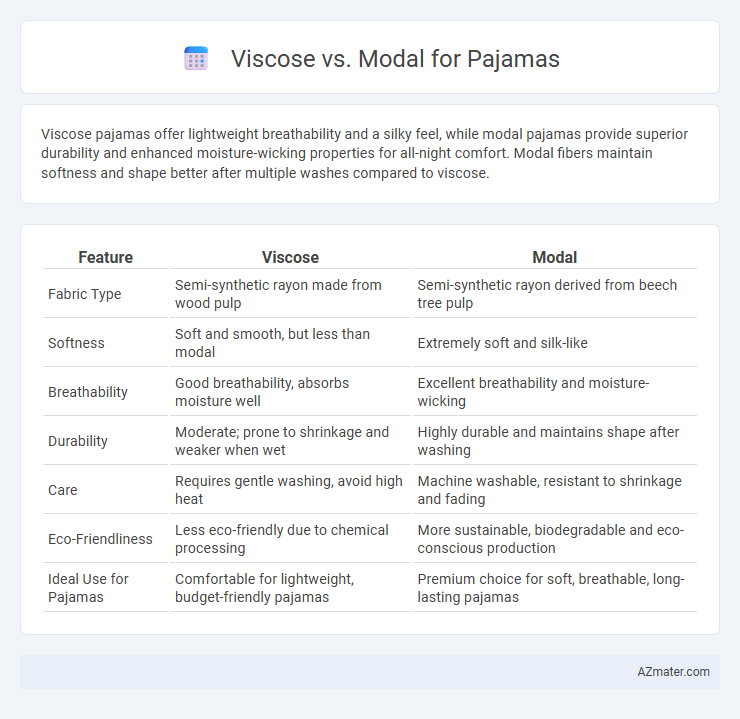Viscose pajamas offer lightweight breathability and a silky feel, while modal pajamas provide superior durability and enhanced moisture-wicking properties for all-night comfort. Modal fibers maintain softness and shape better after multiple washes compared to viscose.
Table of Comparison
| Feature | Viscose | Modal |
|---|---|---|
| Fabric Type | Semi-synthetic rayon made from wood pulp | Semi-synthetic rayon derived from beech tree pulp |
| Softness | Soft and smooth, but less than modal | Extremely soft and silk-like |
| Breathability | Good breathability, absorbs moisture well | Excellent breathability and moisture-wicking |
| Durability | Moderate; prone to shrinkage and weaker when wet | Highly durable and maintains shape after washing |
| Care | Requires gentle washing, avoid high heat | Machine washable, resistant to shrinkage and fading |
| Eco-Friendliness | Less eco-friendly due to chemical processing | More sustainable, biodegradable and eco-conscious production |
| Ideal Use for Pajamas | Comfortable for lightweight, budget-friendly pajamas | Premium choice for soft, breathable, long-lasting pajamas |
Introduction to Viscose and Modal Fabrics
Viscose is a semi-synthetic fiber made from regenerated cellulose, known for its silk-like softness and breathability, making it a popular choice for comfortable pajamas. Modal, a type of rayon derived from beech tree pulp, offers enhanced durability, moisture-wicking properties, and a smoother texture compared to standard viscose. Both fabrics prioritize comfort and softness, but modal tends to provide better resistance to shrinkage and pilling, making it ideal for long-lasting pajama wear.
Understanding the Origins: How Viscose and Modal Are Made
Viscose is a semi-synthetic fiber derived from cellulose found in wood pulp, undergoing chemical treatment to transform natural fibers into soft, breathable fabric ideal for pajamas. Modal, a type of viscose made primarily from beech tree pulp, is produced through a refined process that enhances fiber strength and moisture-wicking properties, making it more durable and comfortable for sleepwear. Both materials offer smooth textures, but Modal's manufacturing method results in a fabric that retains shape better and resists shrinkage, key factors in pajama quality.
Feel and Comfort: Which Fabric Is Softer for Pajamas?
Modal fabric offers a silkier, smoother feel compared to viscose, making it exceptionally soft and luxurious for pajamas. Viscose provides a lightweight, breathable texture but tends to be less supple than modal, which enhances comfort during sleep. Modal's superior moisture-wicking properties and resilience create a cozy, durable option that maintains softness wash after wash.
Breathability and Moisture Management
Modal pajamas excel in breathability due to their naturally porous fiber structure, allowing enhanced air circulation that keeps the skin cool and dry. Viscose, while also breathable, tends to absorb moisture more readily, which can sometimes lead to a heavier, damp feeling during prolonged wear. Modal's superior moisture management wicks sweat away efficiently, making it an ideal choice for pajamas in warm or humid conditions.
Durability and Longevity: Pajamas That Last
Modal fabric offers superior durability and longevity compared to viscose, maintaining its softness and color after multiple washes, making it ideal for long-lasting pajamas. Viscose tends to weaken and lose shape over time due to its lower moisture resistance, which can reduce the lifespan of pajamas. Choosing modal ensures pajamas that withstand frequent wear and retain comfort, providing excellent value for prolonged use.
Sustainability and Environmental Impact
Modal fabric, derived from beech tree pulp, offers superior sustainability compared to viscose, which typically comes from less sustainably sourced wood fibers. Modal production uses less water and energy and generates fewer harmful chemicals, reducing environmental impact significantly. Pajamas made from modal contribute to eco-friendly fashion due to biodegradable properties and more efficient resource use throughout manufacturing.
Maintenance and Care: Washing Viscose vs. Modal Pajamas
Viscose pajamas require gentle washing in cold water with mild detergent to prevent shrinking and maintain softness, while avoiding wringing and direct sunlight drying to preserve fabric integrity. Modal pajamas offer superior durability during laundering, tolerating machine wash on gentle cycles with cold water and retaining their shape and color longer than viscose. Both fabrics benefit from air drying or low heat tumble drying to extend pajama lifespan and maintain comfort.
Color Retention and Appearance Over Time
Modal pajamas exhibit superior color retention compared to viscose, maintaining vibrant hues even after multiple washes due to their higher resistance to fading. The fabric's smooth surface enhances long-term appearance, resisting pilling and maintaining softness over time. Viscose tends to lose color intensity faster and can develop a worn look sooner, making modal a preferable choice for durable, visually appealing sleepwear.
Price Comparison: Cost of Viscose vs. Modal Pajamas
Viscose pajamas generally cost less than modal pajamas due to the simpler manufacturing process and lower price of raw materials like wood pulp used for viscose fibers. Modal, produced from beech tree cellulose with a more eco-friendly and durable treatment, tends to be priced higher but offers enhanced softness and longevity. Consumers choosing based on price will find viscose pajamas more budget-friendly, while modal pajamas represent a premium investment for improved fabric performance.
Final Verdict: Which Is Better for Pajamas?
Modal fabric offers superior breathability and moisture-wicking properties compared to viscose, making it a preferable choice for pajamas in warmer climates. Viscose feels soft and comfortable but tends to wrinkle more easily and is less durable than modal. For long-lasting, breathable, and easy-care sleepwear, modal is the better option.

Infographic: Viscose vs Modal for Pajama
 azmater.com
azmater.com